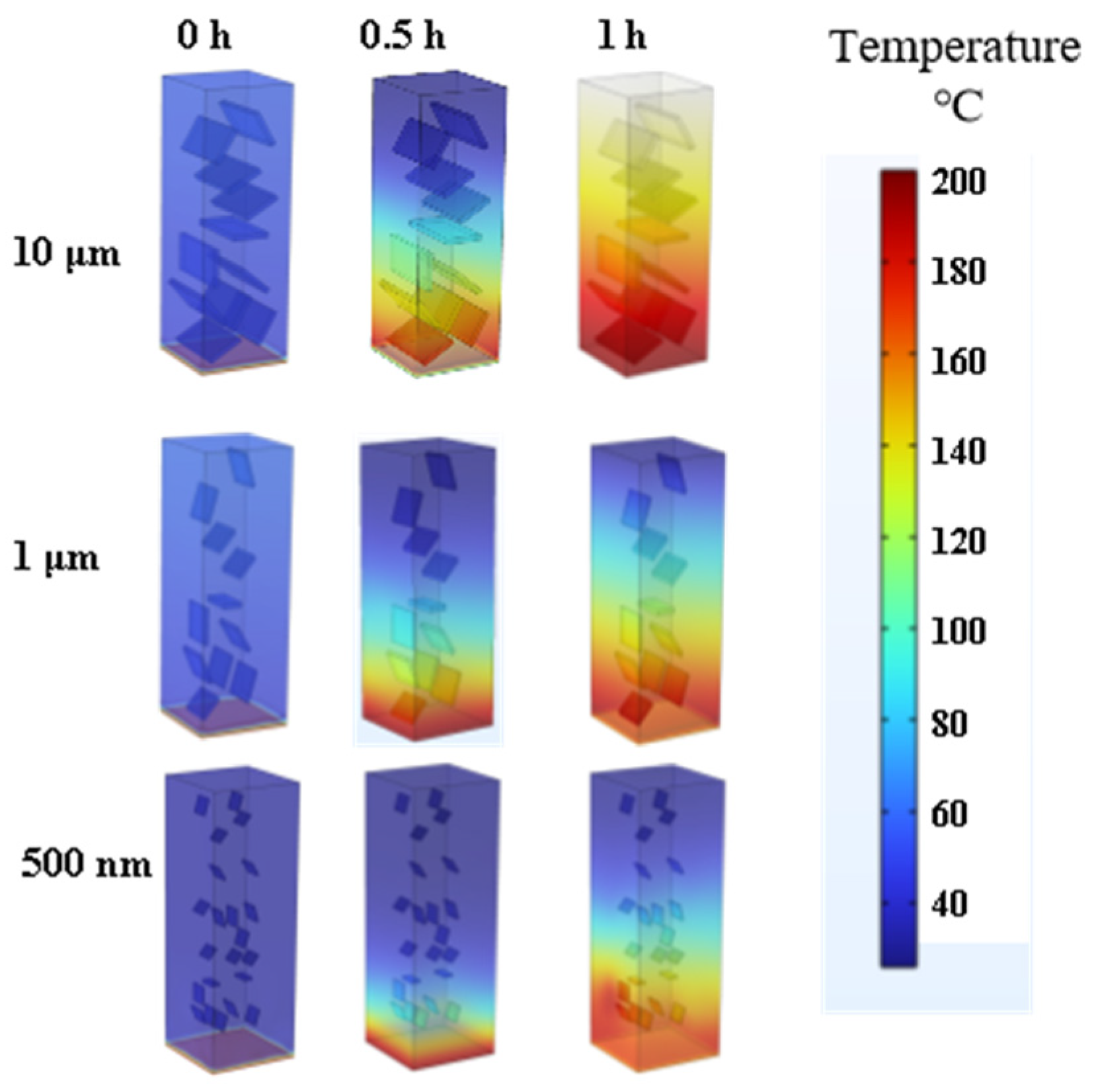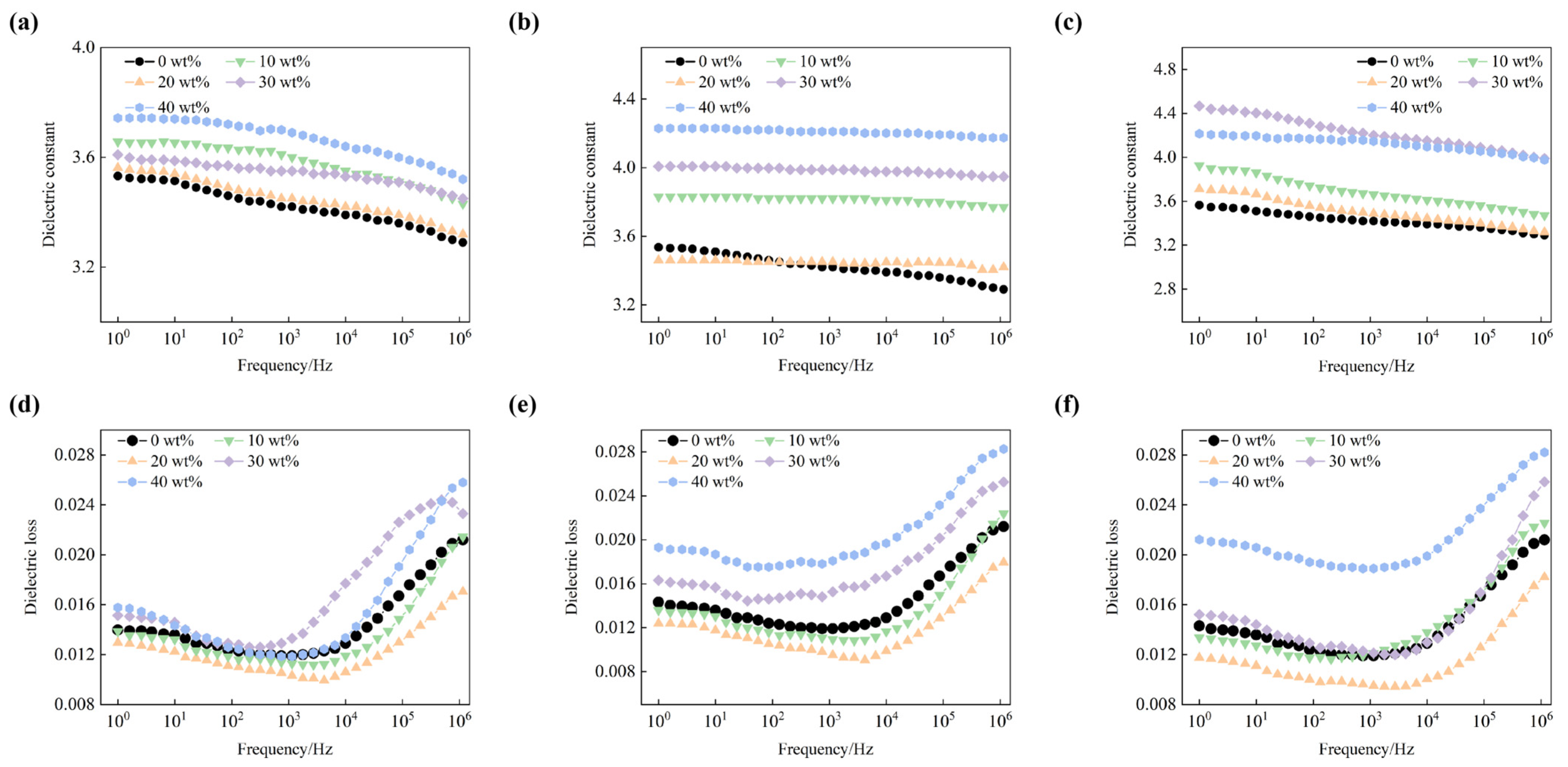The Influence of h-BN Distribution Behavior on the Electrothermal Properties of Bismaleimide Resin
Abstract
1. Introduction
2. Experimental
2.1. Materials
2.2. Preparation of BMI-DBA/DMAA/h-BN Composite Material
2.3. Characterization
3. Results and Discussion
3.1. Synthesis of BMI-DBA/DMAA
3.2. Thermal Conductivity Characteristics
3.3. Insulation Properties
3.4. Dielectric Properties
3.5. Mechanical Properties
4. Conclusions
Author Contributions
Funding
Institutional Review Board Statement
Data Availability Statement
Conflicts of Interest
References
- Wang, Z.; Su, J.; Wang, J.; Feng, Y.; Xu, Q.; Wang, H.; Jiang, H. Unification of Hermal Conductivity, Electrical Insulation, and Electromagnetic Shielding: A Bulk Thermal Conductive Polymer From Solid Waste. Chem. Eng. J. 2024, 498, 155065. [Google Scholar] [CrossRef]
- Al Miaari, A.; Ali, H.M. A Recent Review on Thermal Management of Photovoltaic Panels Using Phase Change Material Based on Thermal Conductivity Enhancers for Sustainable Buildings. J. Energy Storage 2024, 103, 113936. [Google Scholar] [CrossRef]
- Baccega, E.; Vallese, L.; Bottarelli, M. Enhancement of Thermal Conductivity of Paraffin PCM with Metal Foams. Int. J. Thermophys. 2025, 46, 35. [Google Scholar] [CrossRef]
- Li, X.; Wu, B.; Chen, P.; Xia, R.; Qian, J. Covalently Interconnected Carbon Nanotubes Network Enhancing Thermal Conductivity of EP-Based Composite. Compos. Commun. 2023, 40, 101591. [Google Scholar] [CrossRef]
- Wang, Z.; Wu, Z.; Al Masoud, N.; Weng, L.; Alomar, T.S.; El-Bahy, Z.M.; He, M.; Yang, C.; Sun, M.; Wasnik, P.; et al. Effective Three-dimensional Thermal Conductivity Networks in Polystyrene/Multi-walled Carbon Nanotubes/Aluminum Oxide-Hexagonal Boron Nitride Composites Based on Synergistic Effects and Isolated Structures. Adv. Compos. Hybrid Mater. 2023, 6, 125. [Google Scholar] [CrossRef]
- Miao, Z.; Xie, C.; Wu, Z.; Zhao, Y.; Zhou, Z.; Wu, S.; Su, H.; Li, L.; Tuo, X.; Huang, R. Self-Stacked 3D Anisotropic BNNS Network Guided by Para-Aramid Nanofibers for Highly Thermal Conductive Dielectric Nanocomposites. ACS Appl. Mater. Interfaces 2023, 15, 24880–24891. [Google Scholar] [CrossRef]
- Guo, Y.; Ruan, K.; Shi, X.; Yang, X.; Gu, J. Factors Affecting Thermal Conductivities of the Polymers and Polymer Composites: A Review. Compos. Sci. Technol. 2020, 193, 108134. [Google Scholar] [CrossRef]
- Guzman, A.; Garcia, F.; Puma, A.; Gomez-Leon, M.; Palo-Tejada, E. Thermal Conductivity of Insulating Materials Using a Peltier Cell Based Cooling System. J. Phys. Conf. Ser. 2024, 2869, 012002. [Google Scholar] [CrossRef]
- Zhang, Z.; Feng, Y.; Wang, D.; Liang, L.; Wang, Z.; Yang, K.; Chen, X.; Chen, Q. Thermal Conductive Network Construction and Enhanced Thermal Conductivity in Mica Tape Composites for Large Generator Insulation. Compos. Sci. Technol. 2024, 254, 110671. [Google Scholar] [CrossRef]
- Song, Y.H.; Yin, L.J.; Zhong, S.L.; Feng, Q.K.; Wang, H.; Zhang, P.; Xu, H.P.; Liang, T.; Dang, Z.M. A Processable High Thermal Conductivity Epoxy Composites with Multi-Scale Particles for High-Frequency Electrical Insulation. Adv. Compos. Hybrid Mater. 2024, 7, 115. [Google Scholar] [CrossRef]
- Wu, Y.; Ordonez-Miranda, J.; Gluchko, S.; Anufriev, R.; Meneses, D.D.S.; Del Campo, L.; Volz, S.; Nomura, M. Enhanced Thermal Conduction by Surface Phonon-Polaritons. Sci. Adv. 2020, 6, eabb4461. [Google Scholar] [CrossRef] [PubMed]
- Zare, Y. Development of Halpin-Tsai model for polymer nanocomposites assuming interphase properties and nanofiller size. Polym. Test. 2016, 51, 69–73. [Google Scholar] [CrossRef]
- Li, Z.; Zhang, Y.; Wang, X.; Zhang, S.; Tang, B. Thermally Conductive Enhanced Flexible Composite Phase Change Materials for Thermal Management. J. Energy Storage 2024, 85, 111133. [Google Scholar] [CrossRef]
- Van de Putte Gambhir, J.; Gauquelin, N.; Sarantopoulos, A.; Cunha, D.M.; Verbeeck, J.; Koster, G.; Rivadulla, F.; Huijben, M. Reduction of thermal conductivity by nanopillar inclusion inthermoelectric vertically aligned nanocomposites. J. Phys.-Energy 2025, 7, 035009. [Google Scholar] [CrossRef]
- Yin, Q.; Wang, B.; Cai, G.; Wang, Z.; Li, P.; Gao, Y.; Li, K.; Ming, X.; Liu, Y.; Gao, C.; et al. Highly Thermally Conductive Composites of Graphene Fibers. Compos. Part A Appl. Sci. Manuf. 2024, 185, 108290. [Google Scholar] [CrossRef]
- Shulyak, V.A.; Morozov, N.S.; Minushkin, R.A.; Gubin, V.Y.; Vakhrushin, D.V.; Gracheva, A.V.; Nigmatullin, I.K.; Chebotarev, S.N.; Avdeev, V.V. Studies of Thermal Conductivity of Graphite Foil-Based Composite Materials. Materials 2025, 18, 233. [Google Scholar] [CrossRef] [PubMed]
- Chang, H.; Bai, L.; Sun, L.; Wang, D.-Y.; Liu, J.-S.; Li, Z. Research Status of Thermal Conductivity in Copper-Carbon Composite Materials. J. Thermoplast. Compos. Mater. 2024. [Google Scholar] [CrossRef]
- Zhu, S.; Liu, Y.; Qin, J.; Zhang, L.; Wei, Y.; Liu, W. Biobased Imine-Containing Liquid Crystalline Epoxy Resins with Versatile Recyclability and Enhanced Intrinsic Thermal Conductivity. ACS Appl. Polym. Mater. 2024, 6, 13457–13468. [Google Scholar] [CrossRef]
- Zhang, K.; Zhang, J.; Dang, L.; Wu, Y.; He, M.; Guo, H.; Shi, X.; Qiu, H.; Gu, J. High Intrinsic Thermal Conductivity and Low Dielectric Constant of Liquid Crystalline Epoxy Resins with Fluorine-Containing Semi-IPN Structures. Sci. China Chem. 2025, 68, 2615–2627. [Google Scholar] [CrossRef]
- Nam, C.Y.; Lee, J.H.; Kim, M.A.; Yoon, H.G. High Performance and Recyclable Polypropylene/Styrene-Ethylene-Butylene-Styrene Blends for Next Generation Cable Insulation with Enhanced Breakdown Strength Through Controlling Crystallinity. Polymers 2025, 17, 1361. [Google Scholar] [CrossRef]
- Khaled, U.; Beroual, A. AC Dielectric Strength of Synthetic Ester-Based Fe3O4, Al2O3 and SiO2 Nanofluids-Conformity with Normal and Weibull Distributions. IEEE Trans. Dielectr. Electr. Insul. 2019, 26, 625–633. [Google Scholar] [CrossRef]
- Wang, H.; Zhang, Y.; Niu, H.; Wu, L.; He, X.; Xu, T.; Wang, N.; Yao, Y. An electrospinning–electrospraying technique for connecting electrospun fibers to enhance the thermal conductivity of boron nitride/polymer composite films. Compos. Part B Eng. 2022, 230, 109505. [Google Scholar] [CrossRef]
- Liang, Y.; Liu, B.; Zhang, B.; Liu, Z.; Liu, W. Effects and mechanism of filler surface coating strategy on thermal conductivity of composites: A case study on epoxy/SiO2-coated BN composites. Int. J. Heat Mass Transf. 2021, 164, 120533. [Google Scholar] [CrossRef]
- Cui, Y.; Li, M.; Hu, Y.G. Emerging interface materials for electronics thermal management: Experiments, modeling, and new opportunities. J. Mater. Chem. C 2020, 8, 10568–10586. [Google Scholar] [CrossRef]
- Roy, S.; Zhang, X.; Puthirath, A.; Meiyazhagan, A.; Bhattacharyya, S.; Rahman, M.M.; Babu, G.; Susarla, S.; Saju, S.K.; Tran, M.K.; et al. Structure, properties and applications of two-dimensional hexagonal boron nitride. Adv. Mater. 2021, 33, 2101589. [Google Scholar] [CrossRef]
- Drozdov, A.; de Claville Christiansen, J. Modeling thermal conductivity of highly filled polymer composites. Polym. Eng. Sci. 2019, 59, 2174–2179. [Google Scholar] [CrossRef]
- Chen, Y.; Hou, X.; Liao, M.; Dai, W.; Wang, Z.; Yan, C.; Li, H.; Lin, C.T.; Jiang, N.; Yu, J. Constructing a “pea-pod-like” alumina-graphene binary architecture for enhancing thermal conductivity of epoxy composite. Chem. Eng. J. 2020, 381, 122690. [Google Scholar] [CrossRef]
- Wang, X.; Niu, X.; Wang, X.; Qiu, X.; Wang, L. Effects of filler distribution and interface thermal resistance on the thermal conductivity of composites filling with complex shaped fillers. Int. J. Therm. Sci. 2021, 160, 106678. [Google Scholar] [CrossRef]
- Ouyang, Y.; Bai, L.; Tian, H.; Li, X.; Yuan, F. Recent progress of thermal conductive ploymer composites: Al2O3 fillers, properties and applications. Compos. Part A Appl. Sci. Manuf. 2022, 152, 106685. [Google Scholar] [CrossRef]
- Xu, Y.; Soori, T.; Zhang, Q.; Zhu, J.Y.; Nelson, J.K.; Hu, L.; Bahadur, V.; Hebner, R. Boron nitride enhanced electric insulation paper for extendingtransformer thermal life. Mater. Des. 2025, 254, 114112. [Google Scholar] [CrossRef]
- Hong, Z.; Xing, Y.; Xue, M.; Yang, D.; Xia, X.; Guo, J.; Luo, Y.; Yin, Z.; Xie, C. Synergistic effect of BNNS and MgAl layered double hydroxidenanosheets on dielectric properties and thermal conductivity ofpolyetherimide nanocomposite films. Polym. Compos. 2024, 45, 7411–7426. [Google Scholar] [CrossRef]
- Sun, X.; Weng, L.; Liu, J.; Zhang, X.; Guan, L.; Chen, H.; Zhao, W. AIN particles/BN whiskers co-doped epoxy composites modified with polydopamine with high thermal conductivity. Polym. Test. 2023, 129, 108274. [Google Scholar] [CrossRef]










| Size | Mass Fraction (wt%) | 80 °C Viscosity (mPa·s) | Thermal Conductivity λ (W/(m·K)) | Upgrade Rate (η) |
|---|---|---|---|---|
| 0 | 980 | 0.19 | 0 | |
| Sheet diameter l = 500 nm Thickness d ≤ 200 nm | 10 | 2013 | 0.22 | 15.79% |
| 20 | 4595 | 0.29 | 36.84% | |
| 30 | 9806 | 0.34 | 78.95% | |
| 40 | 18,207 | 0.49 | 157.89% | |
| Sheet diameter l = 1 μm Thickness d ≤ 200 nm | 10 | 1797 | 0.28 | 47.37% |
| 20 | 3282 | 0.37 | 94.74% | |
| 30 | 6340 | 0.67 | 252.63% | |
| 40 | 8120 | 1.02 | 436.84% | |
| Sheet diameter l = 10 μm Thickness d ≤ 200 nm | 10 | 1120 | 0.39 | 105.26% |
| 20 | 1753 | 0.69 | 263.16% | |
| 30 | 2890 | 1.01 | 431.58% | |
| 40 | 3945 | 1.31 | 589.47% |
| Size | C1 | C2 |
|---|---|---|
| Sheet diameter l = 500 nm Thickness d ≤ 200 nm | 0.966 | 0.093 |
| Sheet diameter l = 1 μm Thickness d ≤ 200 nm | 1.055 | 0.156 |
| Sheet diameter l = 10 μm Thickness d ≤ 200 nm | 1.192 | 0.489 |
| Size | Mass Fraction (wt%) | Eb (kV/mm) | β |
|---|---|---|---|
| 0 | 24.01 | 17.13 | |
| Sheet diameter l = 500 nm Thickness d ≤ 200 nm | 10 | 25.15 | 13.82 |
| 20 | 23.90 | 15.85 | |
| 30 | 19.74 | 10.72 | |
| 40 | 17.62 | 7.91 | |
| Sheet diameter l = 1 μm Thickness d ≤ 200 nm | 10 | 24.18 | 13.51 |
| 20 | 23.09 | 11.29 | |
| 30 | 20.33 | 12.12 | |
| 40 | 17.86 | 9.69 | |
| Sheet diameter l = 10 μm Thickness d ≤ 200 nm | 10 | 24.43 | 18.48 |
| 20 | 23.58 | 14.42 | |
| 30 | 20.33 | 12.12 | |
| 40 | 18.73 | 13.25 |
| Size | Mass Fraction (wt%) | Activation Energy (eV) |
|---|---|---|
| 0 | 0.522 | |
| Sheet diameter l = 500 nm Thickness d ≤ 200 nm | 10 | 0.426 |
| 20 | 0.473 | |
| 30 | 0.548 | |
| 40 | 0.574 | |
| Sheet diameter l = 1 μm Thickness d ≤ 200 nm | 10 | 0.467 |
| 20 | 0.451 | |
| 30 | 0.515 | |
| 40 | 0.619 | |
| Sheet diameter l = 10 μm Thickness d ≤ 200 nm | 10 | 0.316 |
| 20 | 0.405 | |
| 30 | 0.566 | |
| 40 | 0.793 |
Disclaimer/Publisher’s Note: The statements, opinions and data contained in all publications are solely those of the individual author(s) and contributor(s) and not of MDPI and/or the editor(s). MDPI and/or the editor(s) disclaim responsibility for any injury to people or property resulting from any ideas, methods, instructions or products referred to in the content. |
© 2025 by the authors. Licensee MDPI, Basel, Switzerland. This article is an open access article distributed under the terms and conditions of the Creative Commons Attribution (CC BY) license (https://creativecommons.org/licenses/by/4.0/).
Share and Cite
Li, W.; Wang, X.; Qu, M.; Wang, X.; Shi, J. The Influence of h-BN Distribution Behavior on the Electrothermal Properties of Bismaleimide Resin. Polymers 2025, 17, 1929. https://doi.org/10.3390/polym17141929
Li W, Wang X, Qu M, Wang X, Shi J. The Influence of h-BN Distribution Behavior on the Electrothermal Properties of Bismaleimide Resin. Polymers. 2025; 17(14):1929. https://doi.org/10.3390/polym17141929
Chicago/Turabian StyleLi, Weizhuo, Xuan Wang, Mingzhe Qu, Xiaoming Wang, and Jiahao Shi. 2025. "The Influence of h-BN Distribution Behavior on the Electrothermal Properties of Bismaleimide Resin" Polymers 17, no. 14: 1929. https://doi.org/10.3390/polym17141929
APA StyleLi, W., Wang, X., Qu, M., Wang, X., & Shi, J. (2025). The Influence of h-BN Distribution Behavior on the Electrothermal Properties of Bismaleimide Resin. Polymers, 17(14), 1929. https://doi.org/10.3390/polym17141929





